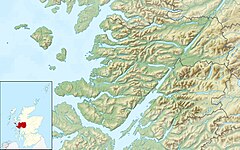
Back River Garry (suba sa Hiniusang Gingharian, Highland) CEB Abhainn Gharadh, Ucheldir yr Alban Welsh Abhainn Gharadh Irish Abhainn Gharadh Scots/Gaelic River Garry (vattendrag i Storbritannien, Highland) Swedish
| River Garry | |
|---|---|
 The River Garry near Invergarry | |
Location of the mouth within Lochaber | |
| Location | |
| Country | Scotland |
| Physical characteristics | |
| Source | |
| • location | The Rough Bounds |
| • coordinates | 57°02′22″N 5°24′24″W / 57.0394°N 5.4066°W |
| Mouth | |
• location | Loch Oich |
• coordinates | 57°04′12″N 4°46′42″W / 57.0701°N 4.7783°W |
| Length | 14.5 miles (23.3 km) |
River Garry | ||||||||||||||||||||||||||||||||||||||||||||||||||||||||||||||||||||||||||||||||||||||||||||||||||||||||||||||||||||||||||||||||||||||||||||||||||||||||||||||||||||||||||||||||||||||||||||||||||||||||||||||||||||||||||||||||
|---|---|---|---|---|---|---|---|---|---|---|---|---|---|---|---|---|---|---|---|---|---|---|---|---|---|---|---|---|---|---|---|---|---|---|---|---|---|---|---|---|---|---|---|---|---|---|---|---|---|---|---|---|---|---|---|---|---|---|---|---|---|---|---|---|---|---|---|---|---|---|---|---|---|---|---|---|---|---|---|---|---|---|---|---|---|---|---|---|---|---|---|---|---|---|---|---|---|---|---|---|---|---|---|---|---|---|---|---|---|---|---|---|---|---|---|---|---|---|---|---|---|---|---|---|---|---|---|---|---|---|---|---|---|---|---|---|---|---|---|---|---|---|---|---|---|---|---|---|---|---|---|---|---|---|---|---|---|---|---|---|---|---|---|---|---|---|---|---|---|---|---|---|---|---|---|---|---|---|---|---|---|---|---|---|---|---|---|---|---|---|---|---|---|---|---|---|---|---|---|---|---|---|---|---|---|---|---|---|---|---|---|---|---|---|---|---|---|---|---|---|---|---|---|---|
| ||||||||||||||||||||||||||||||||||||||||||||||||||||||||||||||||||||||||||||||||||||||||||||||||||||||||||||||||||||||||||||||||||||||||||||||||||||||||||||||||||||||||||||||||||||||||||||||||||||||||||||||||||||||||||||||||
The River Garry (Scottish Gaelic: Garadh / Abhainn Gharadh) in Inverness-shire is a Scottish river punctuated by two long Lochs, in the region of Lochaber. It flows broadly west to east through Glen Garry, starting in a wilderness to the east of Knoydart and ending at Loch Oich in the Great Glen, which forms part of the Caledonian Canal. There are a few tiny settlements within Glen Garry, but the only village of any size near to the river is Invergarry, at its mouth. Loch Quoich at the western end of the watercourse is dammed by the largest mass earth fill dam in Scotland, and supplies water to Quoich hydroelectric power station. Loch Garry is dammed by a much smaller dam in the gorge where the river begins its descent to Invergarry, and supplies water to Invergarry hydroelectric power station, close to the mouth of the river. Both hydroelectric schemes were built in the 1950s, with the aim of stimulating economic regeneration in the area. They have altered the ecology of the river, as both lochs were made considerably bigger as a result of constructing the dams.
The two lochs were an important factor in the construction of the Caledonian Canal, which was completed in 1822, and the commissioners were empowered to embank them to ensure that the canal had enough water to operate the large locks. In practice, clearing of rocks from the river channel where it exited Loch Garry and the fitting of a sluice to control the outflow from Lock Quoich were the main modifications made to the waterway by the canal commissioners.
© MMXXIII Rich X Search. We shall prevail. All rights reserved. Rich X Search
